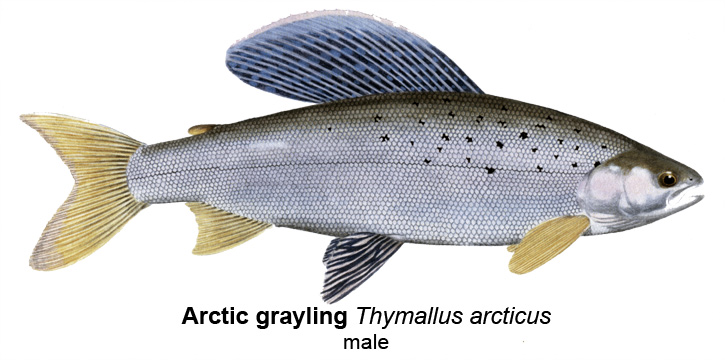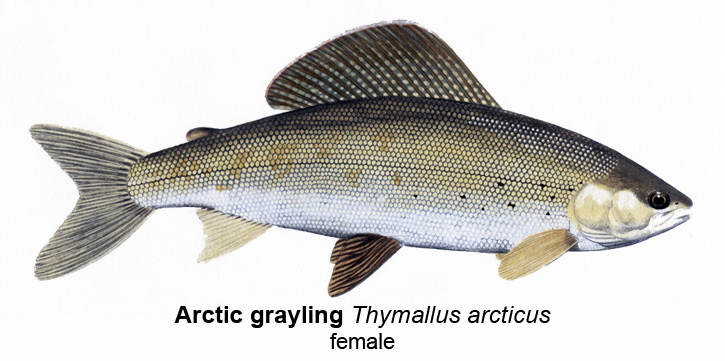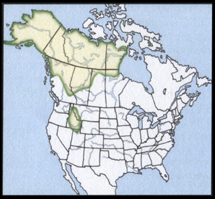Grayling, March 2013, Fish of the Month!

 Arctic grayling
Arctic grayling
Thymallus arcticus
Local Names:
Grayling, Bluefish, Sailfin Arctic grayling, Arctic trout, Back's grayling
Average Size:
10 to 16 inches
0.50 to 1.50 pounds
Distinguishing Field Marks:
Color and color pattern are reliable distinguishing field marks for this species. (See the illustrations.)
The Arctic grayling cannot be confused with any other North American fish species within its range.
-
The colorful, sail-like dorsal fin of both sexes is a reliable field mark.
Arctic grayling have small heads and very small mouths, with the upper jaw typically extending only to the mid-point of the eye.
-
The caudal fin is deeply forked with the tip of the lower lobe round, and the upper pointed. The lower lobe is often longer than the upper.
-
In both males and females, the paired pelvic fins are strongly marked with wavy lines.

North American Range:
Map to the right shows approximate range in North America.
Biology:
Arctic grayling spawn in very early spring, usually entering spawning areas from ice covered lakes and ponds in March. Spawning takes place at temperatures of 44.6 to 50 degrees F., always during mid-day when the water is at its warmest.
Unlike trout and salmon, grayling defend nesting territories and mates with lateral body and erect fin displays, rather than direct physical attacks. Also unusual for the family is the fact that nests are not dug, rather the bottom of the site is cleared by the female's fanning her tail fin over it to remove silt and other debris. After spawning the parent fish move immediately back to the main river or lake. Females carry from 4,000 to 7,000 eggs. These incubate only 2 to 3 weeks before hatching. Fry spend 8 days absorbing the yolk sac, but may begin feeding in about 3 days. Early in their lives, Arctic grayling grow rapidly, but this rate slows later on especially in more northern habitats.
Diet:
Zooplankton, graduating to aquatic and terrestrial insects and other invertebrates. Larger specimens occasionally eat small fish and fish eggs. The majority of grayling food consists of aquatic and terrestrial insects usually taken at or near the surface.
Fly Fishing for Arctic Grayling:
Within its historic range in the contiguous United States, the Arctic grayling has been reduced to near extinction. The northern Rocky Mountains, western Canada and Alaska are the only places remaining where grayling are still abundant.
Look for this fish in cold clear rivers and larger streams and lakes.
Arctic grayling tend to school, investigate anything resembling food at the water's surface, jump when hooked, and are extremely beautiful. They are a fish that seems to have been made for the top-water fly fisherman. Match-the-hatch or searching dry flies, tending toward the smaller sizes, are the best places to start your grayling attraction investigations. If you're actively targeting grayling, you'll want to use light gear, in the 3 to 5 weight range. Although they don't attain large size, these small soft-mouthed fresh water sail fish are good fighters and much inclined to taking to the air when hooked. That, and the fact that they are undeniably beautiful makes them a pleasure to catch and release.
Search the internet for prime locations in which to find Arctic grayling. As always, carefully review all state and provincial regulations before fishing for this species.
Significance to Humans:
As they were and are abundant in the northernmost parts of their range, Arctic grayling have been and continue to be mainly used as a source of dog food for far northern native peoples. They are usually dried to prevent spoilage. Anglers visiting the far north will find this fish a pleasant diversion from the usually sought trout and salmon.
Status:
The Arctic grayling has been exploited to extinction or near-extinction in most of the southern parts of its natural range, including the western Great Lakes watersheds and Oregon. It is maintaining in its northern and Rocky Mountain ranges primarily because of the difficulties in reaching the remote locations where it lives.






